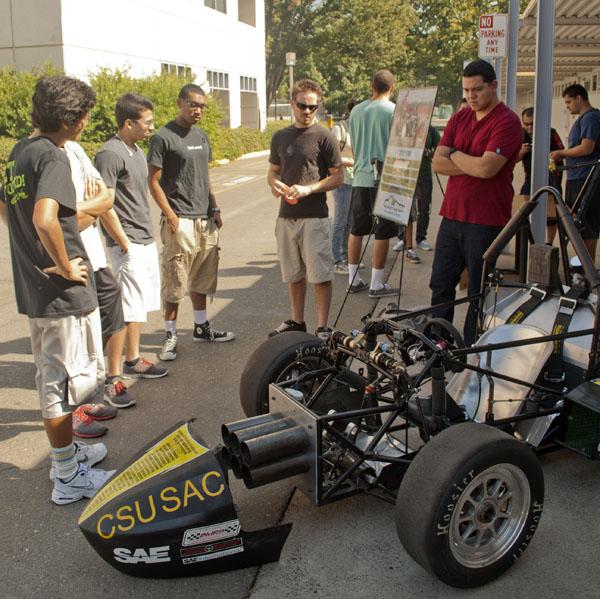Hornet Racing Team revving up

The Hornet Racing Team inspects the design of their new kart. They intend to compete next summer.
October 10, 2012
The Hornet Racing Team is on the road to competition at Formula SAE, an event taking place in Lincoln, Neb., while expanding their horizons and attempting to include other members of the Sacramento State community.
SAE, or the Society of Automotive Engineers, sponsors the annual design competition where students from 85 colleges and universities come together to race their four-wheeled work around an 82-acre track.
Though this is the first year electric cars will be allowed on the track, the Hornets will only be competing against those schools’ cars with traditional gas engines.
Senior mechanical engineering major Marcos Navarro, a senior member of the club, said the competition is more of a management project than a race competition. The judges will continue to question team members about their design choices until members do not know the answers.
“Ideally, you want to list your main points about the car, all the documentations, all the figurations…the theory behind everything,” said Navarro. “You can’t just say ‘This is my theory.’ You have to show testing.”
The first and second days of the competition are for technical inspection and design, including any modification necessary for safety. Dynamic tests occur on the third and fourth days, such as testing acceleration and the 20-minutes-two-kilometers endurance race.
The club started designing its car a month ago for Formula SAE. There are three aspects of car creation: design, manufacturing and testing. The team uses SolidWorks, a French-made 3-D mechanical modeling program to design the car. Next comes manufacturing, and lastly testing to see if the car parts work while the car is moving.When that is all completed, the drivers are selected.
Technical director Ryan Hart, a senior mechanical engineering major, focuses on the testing portion and knows where to purchase car parts.
“Traditionally, it takes longer to do the design and manufacturing, but we plan to reverse that this year so we have more time to test and fix things like the cockpit or suspension or make a part,” Hart said. “Because we tested (the car over and over again), the judges really like that because we (validated) our design.”
Brandon McLaren, an amateur 125-cc shifter kart racer and regular driver of 115-mph karts, will hold the Driver Development Program at Sacramento State in November. The program is open to anyone interesting in becoming a driver for the competition.
“We are going to work (interested drivers) through operating the car, what the car does, go through some theory and get them up to speed about what race cars are all about,” Hart said. “Things happen…faster in a race car than a street car.”
The club will also go to Race Place Motorsports, an indoor kart racetrack in Rancho Cordova, to test potential drivers. Afterwards, club leaders will test finalize by setting up cones in one of the open parking lots the way the competition tracks will be set and choose the two fastest drivers.
Members and faculty have had several different experiences from past competitions, such as Navarro interacting with automotive professionals such as Honda and Ford in this year’s summer competition. Apart from getting the opportunity to meet professionals, in general, Hart felt event organizers yelling at several teams and treating them as high school students was unnecessary.
“Most of us are a little older such as transfers or have worked for a while and then gone back to school. I would prefer (event organizers) to just come and talk to me like an adult,” Hart said.
Mechanical engineering professor Akihiko Kumagai, adviser of the Hornet Racing Team, said the only action the club could take is plan.
“It is an event. You have to expect the unexpected. Nothing goes the way you want,” said Kumagai.
Navarro added that variables, like teams dropping out or sponsors not giving money or car parts after all, always exist.
Once the club completes designing, the club will build the car. The car must be 80 percent rebuilt and 20 percent can be from a previous design.
“We wanted to keep the overall design the same because senior members, who had three to four years of experience, graduated,” said Navarro.
Hart said joining the team is a good opportunity for all majors – not just engineering students.
“There’s a huge business opportunity,” said Hart. “Marketing, public relations — how to budget finances when we spend money. There’s web design, graphic design (and we) actually had an English major writing press releases for us until she could not participate anymore.”
The Hornet Racing Club launched an unpaid internship this semester, which is posted on the business department’s website and soon the club will add information about the internship on its website and Facebook page.
Kiran Kaur can be reached at [email protected]




























































































































